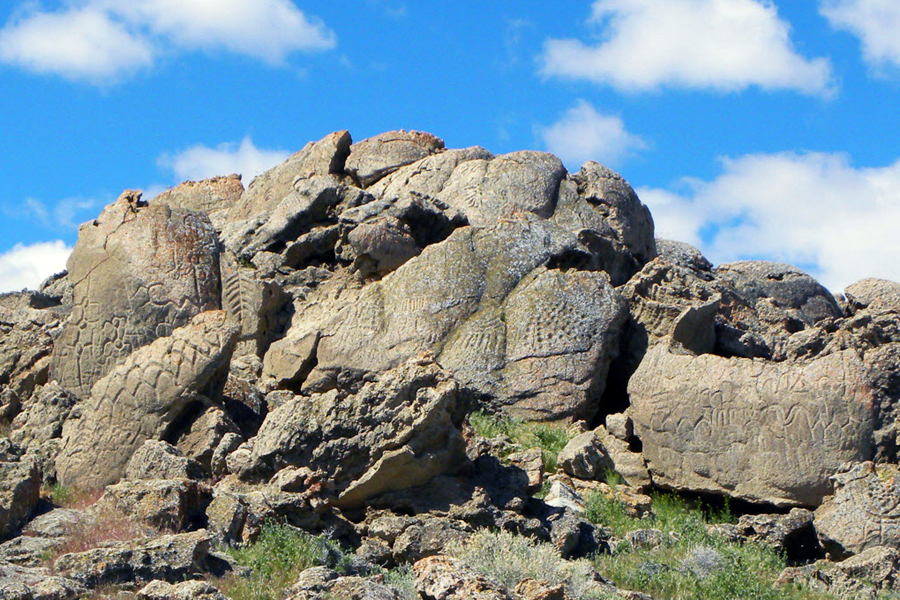Oldest petroglyphs in North America confirmed in Nevada
Loading...
| PYRAMID LAKE, Nevada
Ancient rock etchings along a dried-up lake bed in Nevada have been confirmed to be the oldest recorded petroglyphs in North America, dating back at least 10,000 years.
The petroglyphs found on limestone boulders near Pyramid Lake in northern Nevada's high desert are similar in design to etchings found at a lake in Oregon that are believed to be at least 7,600 years old. Unlike later drawings that sometimes depict a spear or antelope, the carvings are abstract with tightly clustered geometric designs — some are diamond patterns, others have short parallel lines on top of a longer line.
Scientists can't tell for sure who carved them, but they were found on the Pyramid Lake Paiute Tribe's reservation land.
"We initially thought people 12,000 or 10,000 years ago were primitive, but their artistic expressions and technological expertise associated with these paints a much different picture," said Eugene Hattori, the curator of anthropology at the Nevada State Museum in Carson City who co-wrote a paper on the findings earlier this month in the Journal of Archaeological Science.
The petroglyphs could be as much as 14,800 years old, said Larry Benson, a geochemist who used radiocarbon testing to date the etchings and was the lead author of the research paper.
Radiocarbon testing dated the carbonate layer underlying the petroglyphs to roughly 14,800 years ago. Geochemical data and sediment and rock samples from adjacent Pyramid Lake show they were exposed to air from 13,200 to 14,800 years ago, and again from 10,500 to 11,300 years ago.
"Whether they turn out to be as old as 14,800 years ago or as recent as 10,500 years ago, they are still theoldest petroglyphs that have been dated in North America," said Benson, a former research scientist for the U.S. Geological Survey and current curator of anthropology at the University of Colorado Natural History Museum in Boulder.
Dennis Jenkins, an archaeologist with the University of Oregon's Museum of Natural and Cultural History, called it a significant discovery. He led recent excavations of obsidian spear points near Paisley, Oregon, that he dated back 13,200 years, and noted that the bigger challenge is identifying who created the petroglyphs.
"When you get back into this time period, if you speak with Native Americans they will tell you they were made (created) there and that is obviously their people and their artwork," Jenkins said. "But approaching it from a scientific point of view — what we can prove — at this point, it is impossible to connect these to any tribal group."
William Cannon, a longtime archaeologist for the U.S. Bureau of Land Management who discovered thepetroglyphs at Long Lake in Oregon, brought the Nevada site to Hattori's attention years ago. He said they bore similarities to petroglyphs at nearby Winnemucca Lake, and Hattori began connecting the dots after Benson spotted the carbonate coating on the rocks.
The etchings in Nevada and Oregon have relatively deep, carved lines dominated by linear, curved and circular geometrical designs. Some feature "tree-form designs" with a series of evenly spaced, vertically oriented 'V' shapes bisected by a vertical line.
Researchers have suggested the etchings represent various meteorological symbols, such as clouds and lightning, perhaps the Milky Way.
"But we really have nothing to go on for these particular petroglyphs that go back 10,000 or more years," Hattori said Wednesday.
Benson has no idea what they mean.
"When I looked at it, I said, 'These things are incredibly beautiful.' We have so much beautiful, old Native American stuff in the United States, but this shows it didn't necessarily get more interesting or more pretty with time," he said.
Ben Aleck, a co-author of the study who is the collection manager at the Pyramid Lake Paiute Tribe's Museum and Visitor Center in Nixon, said Wednesday he could not comment without permission from tribal leaders.







